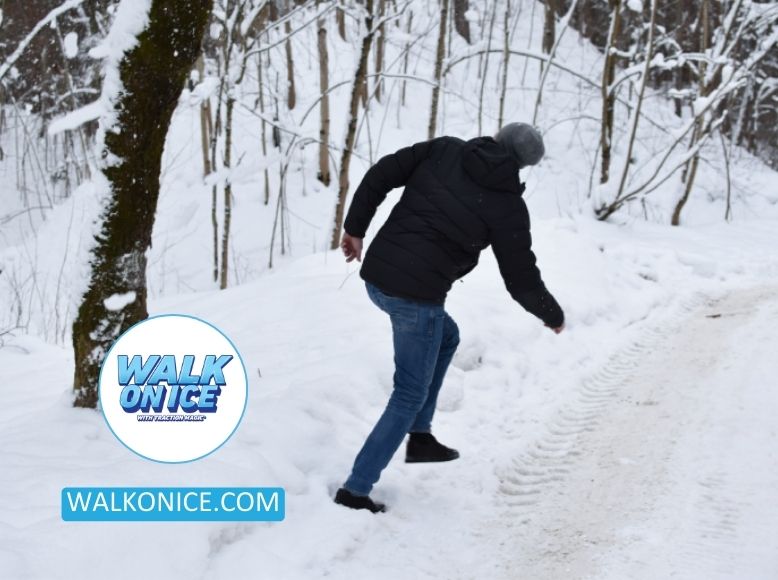What To Do If You’ve Slipped On Ice

It’s winter time and that means you might find yourself on the ice at some point. It is important to know how to walk on ice and snow. But it is also necessary to know what to do in case of a slip and fall accident.
We’re going to talk about what to do if you’ve slipped on ice and some walking on ice safety tips, so read on!
- The First Thing To Do Is To Stop
If you’ve slipped on ice, the first thing to do is stop. You may have suffered some cuts and bruises, but if you can, put pressure on the wound to help prevent further bleeding. If your ankle or leg feels broken, call for help immediately. Otherwise, set up a splint using sticks found in the area.
If you’re able, elevate the area above your heart level and apply ice packs or cold compresses to reduce swelling and pain. If possible, stay off of your feet until medical help arrives.
- Attend To The Injury
If you have a minor injury, then try to keep moving. If you can’t move and are in danger of losing body heat quickly (in a very cold environment), get out of the wind and into a shelter as soon as possible. If you have slipped while walking on ice, it is important that you attend to your injuries first before attempting to walk again.
If there is no one around who could help with first aid, then call an ambulance or go directly to a hospital for treatment.
Get ready for winter with Walk On Ice instant traction on snow and ice
- Don’t Move
You’re going to want to stay still. You may have injured yourself, and moving around could make the injury worse. Moving could also cause further damage, so trying not to move will help prevent that.
The best thing you can do is stay calm and wait for help from someone else or from emergency personnel who will be able to assist you with your injuries.
- Call For Help
If you are alone and need help, call 911.
If you have a mobile phone, call the emergency services. If not, ask anyone nearby to dial 911.
- While You’re Waiting, Try To Keep Warm
If you can, it’s a good idea to try to keep your body temperature up. If you’re in public, find somewhere warm and safe. If you’re home alone, try running the heat or turning up the thermostat.
- Use Traction Agent – Walk On Ice
To prevent these slips and falls in the future, try using traction agents like Walk On Ice when you’re walking on slick surfaces. The mud-like granules of Walk On Ice comprise 7 naturally occurring geo crystals that act as absorbers and grippers. The absorbers siphon off the water while the grippers hold onto the ice or snow to create a non-slip surface. You can spread it on the steps, under the tires, or when getting out of the vehicle to get instant traction. It helps to maintain a good grip and does not stick to the shoes.
How To Walk On Ice Without Slipping
Once you’ve tended to an injury or gotten help after a fall, the next step is prevention—because no one wants a repeat performance. So, how to walk on ice without slipping? It’s about combining technique, gear, and awareness. Think “penguin steps”: short strides, slightly bent knees, and your arms free to balance. Keep your weight slightly forward instead of leaning back, because leaning backward makes you more likely to lose footing.
Another smart trick is to treat every shiny patch as suspicious. If it looks glossy, assume it’s ice—even if you can’t see it clearly. Black ice, for instance, is notorious for catching people off guard. Using traction products like Walk On Ice along your path can turn these slick areas into a safer surface, but practicing careful walking habits is just as critical.
And don’t forget: practice makes perfect. The more you get used to shuffling and stabilizing yourself, the less likely you are to panic and slip.
How To Make Wood Stairs Non Slip In Winter
Falls on icy sidewalks are bad enough, but wooden stairs can be even more treacherous. If you’re wondering how to make wood stairs non slip, you’ve got a few options.
- Outdoor stair treads: Rubber or composite strips can be applied to the steps to create extra grip. They’re especially effective when paired with regular snow clearing.
- Anti-slip coatings: Special paints or sprays can be applied to wooden surfaces to add traction, though they’ll need reapplication every season.
- Traction agents: Quick fixes like Walk On Ice are perfect when you need immediate grip without permanent modifications.
And yes, some folks use kitty litter for ice on stairs too—but remember, it won’t melt the ice, and wet litter quickly turns messy. If you want a cleaner, safer option, stick with mineral-based traction products or stair treads designed for winter.
If you’ve got pets, that’s another layer to consider. Non-slip stair solutions should be gentle on paws, which is why harsh salts and chemical deicers are best avoided. Natural agents give you grip without leaving behind residue that harms your wood or your furry friends.
Cleats For Walking On Ice: Do They Really Help?
Another tool in your winter safety kit could be cleats for walking on ice. These slip-on devices attach to your regular shoes or boots, digging into ice and snow like tire chains on a car. They work particularly well if you’re going to be outdoors for longer stretches—say walking the dog, running errands, or trekking to work.
But cleats aren’t always convenient. They’re not meant for indoor use (they can damage flooring), and they can feel clunky if you need to switch between icy sidewalks and dry pavement. That’s why many people keep them handy but not as their only solution. Pairing cleats with a traction agent like Walk On Ice gives you both mobility and flexibility—you’ve got the extra grip underfoot, and you can also make the ground itself safer for others.
So yes, cleats do help, but they work best as part of a larger winter safety plan rather than as your single defense against slips.
Kitty Litter For Ice: A Common Misconception
By now you’ve probably heard at least one neighbor say they keep a bag of litter in the garage “just in case.” And sure, using kitty litter for ice can provide some grip, but let’s set the record straight—it’s not a magic bullet. Litter doesn’t melt ice. It only adds a rough layer over it. And depending on the type of litter, it can become clumpy and slick when wet, actually making the situation worse.
If you do go this route, choose non-clumping varieties, which stay grainy longer and are easier to sweep up afterward. But for the effort and cleanup required, you may find it easier to use sand for traction or skip directly to Walk On Ice for instant, no-mess results.
Remember, prevention is about balancing convenience, safety, and cleanliness. Kitty litter checks the “cheap” box, but not necessarily the “effective” or “easy to clean” ones.
Wrapping It Up: Safety After A Slip
So here’s the bigger picture: knowing what to do if you’ve already slipped on ice is just half the story. The other half is making sure you don’t repeat the same accident. Learning how to walk on ice without slipping, figuring out how to make wood stairs non slip, considering cleats for walking on ice, and even questioning whether kitty litter for ice is worth the hassle—all of these steps help create a safer winter routine.
Walk On Ice remains one of the smartest additions to your toolkit because it’s fast, natural, and effective, but habits like careful walking and stair prep are equally important. Combine them, and you’re not just surviving the winter—you’re walking through it confidently.
Other Ice Melt Products
Safe Paw
The Original and #1 Selling Pet and Child Safe Ice Melt for over 20 years. Guaranteed environmentally safe – will not harm waterways and sensitive wetlands. All products are made in the USA.

Safe Thaw
Imagine an ice melt you can put down and never worry about. It won’t harm pets, kids, and your property. That’s Safe Thaw. Unlike anything else on the market, Safe Thaw can change how winter affects our planet.



